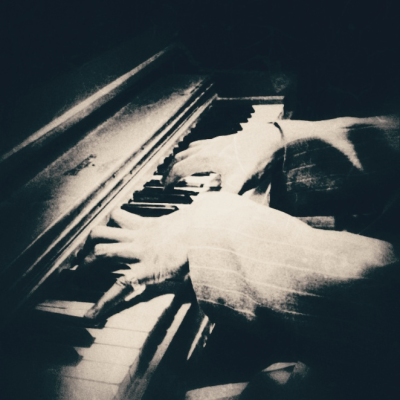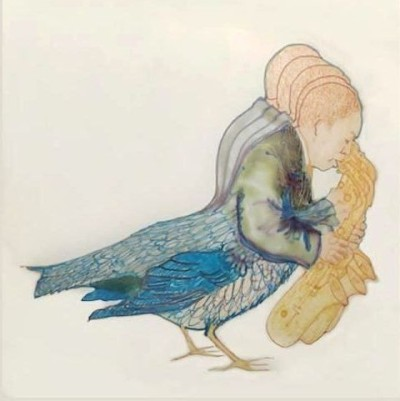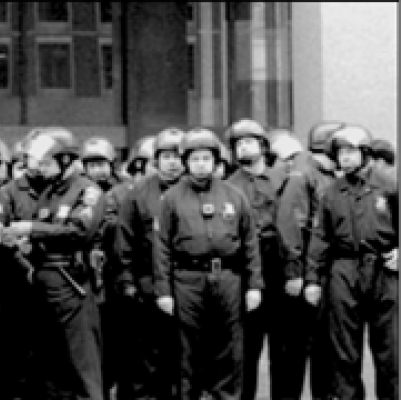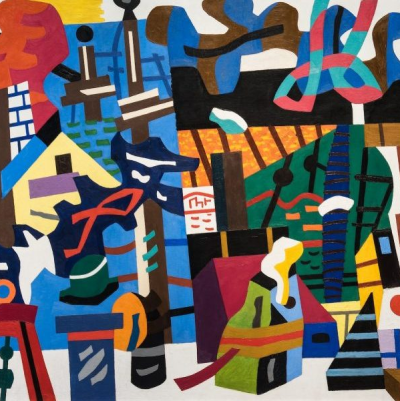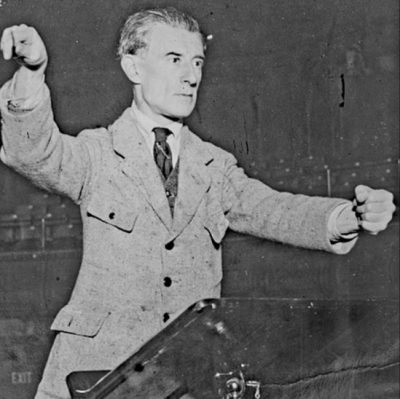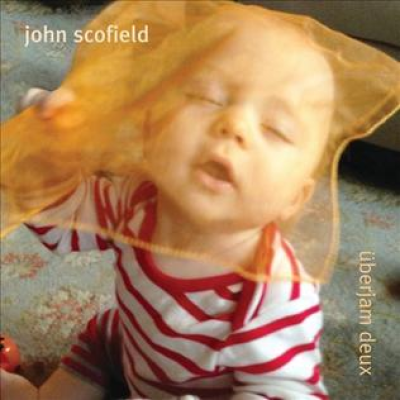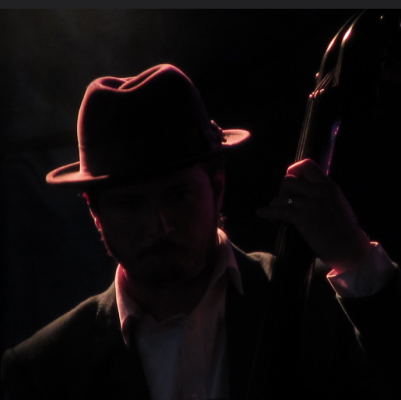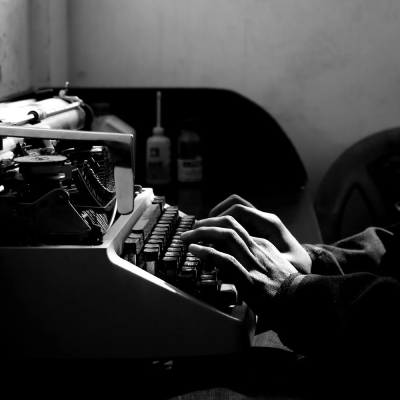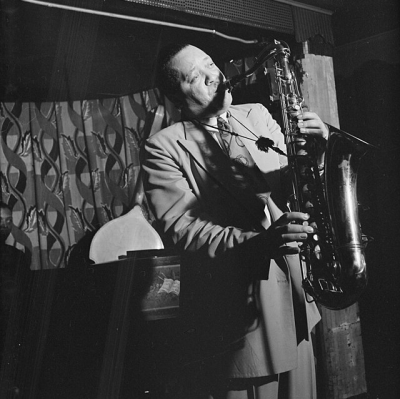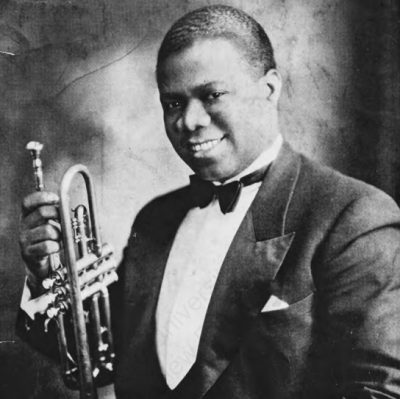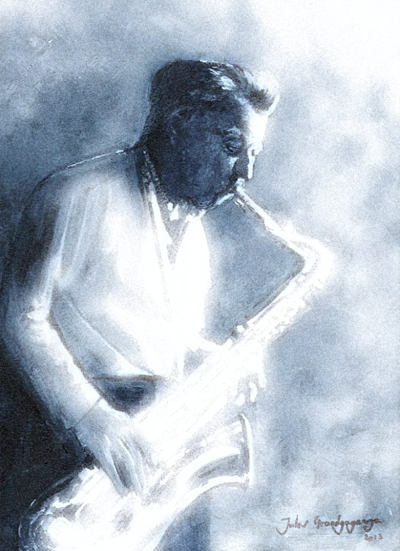.
.
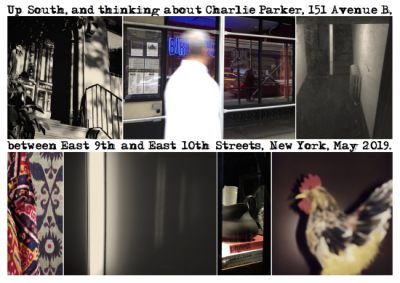
.
“Thinking About Charlie Parker” is one of several photo-narratives in Charles Ingham’s new series devoted to his love of jazz music, “Charles Ingham’s Jazz Narratives”
These photo-narratives are provocative and meaningful – connecting time, place, and subject in a way that ultimately allows the viewer a unique way of experiencing jazz history.
To enhance the opportunity for appreciation of this artistic series, in the coming weeks “Charles Ingham’s Jazz Narratives” will be featured on Jerry Jazz Musician three-at-a-time, and will include the artist’s description of each piece.
.
The first three, found below the artist’s introduction, are:
“Thinking About Charlie Parker”
“Monk and Nellie Headed North”
“Out West, Thinking About Chet Baker”
.
.
_____
.
.
Charles Ingham introduces his “Jazz Narratives” series
.
…..Jazz has always been there for me. Music is an essential part of my life, and I have eclectic tastes, but there has always been jazz music. At seventeen, I’m at a Rahsaan Roland Kirk concert in my hometown of Manchester, England, stunned by the transgressive beauty of this man’s performance. At fifty-seven, my wife has died, and I can’t bear to hear lyrics, so it’s Kind of Blue and Trane ballads. And today I’m listening to ‘Round Midnight, Monk alone at the piano, stunningly honest and almost unbearably intimate.
…..So as an artist I need to give something back, but make it my own, and make it new.
…..As a conceptual artist, my photo-narratives are hybrid forms, transgressing distinctions between the verbal and the visual: the image as text. My art represents a combinatory aesthetic; each work constitutes a whole made up of parts, creating something of a symbiosis: the words, the images (abstract and referential), the space between images, the subjects, the reference to specific individuals, places, or times. As the artist Alexis Smith says of her collages and assemblages: “It’s fused into a whole where they seem like they’ve always been together, or were meant to be together. The people that look at them put them together in their heads.” Some visual references are obvious; some of the bones, sinews, and other connective tissue that hold a particular narrative together work within the piece’s own logic, a logic that viewers find for themselves. Here, the artist makes the work, and that work has an agenda, but a significant part of that agenda is for the viewer to find something of (or for) themselves within these images and words.
…..Each work in this series of “Jazz Narratives” is anchored by a person (a musician) and a related place. I am especially interested in the “aura” of these places. Sometimes, the place remains relatively unchanged seventy years after the musical fact; sometimes, only a physical street number remains, if that. What matters is that, for the artist and the viewer, this aura remains. This, say, is 151 Avenue B, on the Lower East Side; the brownstone is easy to miss if you are walking along the east side of Tomkins Square Park, but if you know that Charlie Parker lived there, it has become something more than the stone and glass of the place. 4201 S. Central Avenue, Los Angeles, is an anonymous mixed-use building, but there’s the number above the glass doors; 4201 S. Central is the Downbeat Club. Here, in 1945, Clora Bryant first heard bebop: here, on this corner, and that corner is still here, as is that night and all those other nights.
…..Some years ago in Brooklyn, I went looking for 99 Ryerson Street, where the poet Walt Whitman had lived when Leaves of Grass was first published. The fact that Whitman had lived here had only recently been discovered, and the 1850s wood-frame house was unmarked and unchanged except for aluminum siding and the addition of an extra floor. It is the only surviving Whitman residence in Brooklyn and Manhattan. Standing on the original bluestone sidewalk slabs, I was looking at Whitman, whose vision of America was a primary reason for my decision to emigrate to the United States. In my excitement, I crossed the street and spoke to an elderly man sitting on the stoop opposite. “Do you know that Walt Whitman lived in that house?” I asked, clearly appearing to be a madman. The neighbor looked up at the crazy person: “Is that the guy who is renting a room?” For him, the aura was not visible.
…..These pieces are works of homage; I am making some kind of unsentimental pilgrimage to each of these apparently anonymous street addresses. And I am conjuring ghosts; they are still alive in these places as they are in their recordings. The music may have been recorded in 1947, but they are playing it now. You can hear that. And, if I am successful, you can see the musicians in my art.
.
_____
.
.
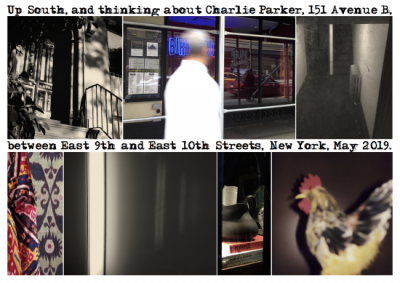
Thinking about Charlie Parker
(151 Avenue B, New York)
2019
.
…..An homage to the musician. Between 1950 and 1954 (a year before his death), Charlie Parker lived with Chan Richardson in the ground-floor apartment of 151 Avenue B. Facing the east side of Tompkins Square Park, the building itself is striking: a rare example of a row house built in the Gothic Revival style. Parker’s four-year stay in this downtown apartment would be the longest period he spent at any one address while living in New York. He and Chan would have two children here, although in March 1954 his three-year-old daughter Pree would die of congenital heart failure, a tragedy, some would argue, from which Bird never recovered.
…..The work leads with an image of the stoop and front door of the house. I was in the Lower East Side early on a spring evening, just when there was wonderful light hitting the northwest-facing front of #151, casting tree shadows. As I have noted, Bird and Chan occupied the ground-floor apartment (they had a garden), but unlike the ground-floor frontage, the grand stoop and impressive front door make a statement, and do justice to the man.
…..Similarly, I know that the West 44th Street Birdland depicted in my piece is the third incarnation of the original club, but I wanted that neon sign. I also wanted a passerby to partially obscure the sign, so that the statement of the image is a little more subtle. The scaffolding covering the façade of the building also does interesting things visually, echoing the breaks between other images in the piece, and nicely breaking up and framing this image, not least the reflection of the street (including, for heaven’s sake, a glimpse of a yellow cab!).
…..In one image, the book entitled Protest is perhaps a nod to the revocation of Parker’s cabaret card by a corrupt, puritanical, and racist NYPD. Protest.sits atop a copy of Soul of a Nation, the catalog of a recent museum exhibition subtitled “Art in the Age of Black Power.” The title Soul of a Nation is apt.
…..And perhaps that is a yardbird closing the narrative of this piece.
…..Regarding this work and the other works in this series, I do not wish to say too much more about this piece – about the bones, sinews, and other connective tissue that hold this photo-narrative together. However, as always, I invite the viewer/reader in to find their own narrative within this piece.
.
___
.
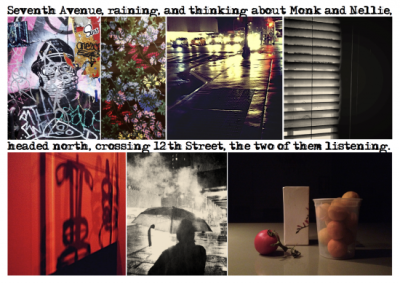
Monk and Nellie Headed North
(7th Avenue at 12th Street, New York)
2019
.
…..Thelonious Monk and Nellie, his wife, leaving the Village Vanguard and heading home. The two of them absorb everything around them, so that we can hear it later, broadcast from Monk’s piano.
…..Me, leaving the Vanguard in the rain, tracing a giant’s footsteps. Heading for the 14th St. subway station.
.
___
.
.
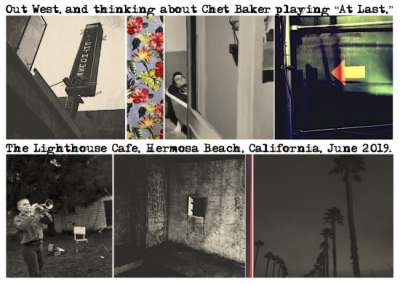
Out West, Thinking about Chet Baker
(30 Pier Ave., Hermosa Beach, California)
2019
.
…..The Lighthouse Café is still here, perched on the edge of the Pacific Ocean. Inside, on Sundays, jazz music is still played. As Ted Gioia observes, “an unlikely locale to make jazz history.”
…..In 1945, the fifteen-year-old Chet Baker moved with his parents from Glendale to Hermosa Beach, the Lighthouse, four years away from being a jazz club, within walking distance of their home. In the 1950s, living in Lynwood, Baker would guest with the Lighthouse All Stars, as would Gerry Mulligan, Miles Davis, Max Roach, and Charlie Parker.
…..Here, in a fragment from the 1960 Italian film Urlatori alla sbarra (roughly “Howlers on Trial”), Chet is in a bathtub cradling his trumpet. Nodding off in the bath during a party, Baker plays a character referred to as Americano. And here is a photograph of a young man playing the trumpet.
…..A dark piece. Intimations of mortality.
.
.
To see Volume 1 of this series, click here
To see Volume 2 of this series, click here
To see Volume 3 of this series, click here
To see Volume 4 of this series, click here
To see Volume 5 of this series, click here
To see Volume 6 of this series, click here
To see Volume 7 of this series, click here
To see Volume 8 of this series, click here
To see Volume 9 of this series, click here
.
___
.
.
photo by Jacqueline Ramirez
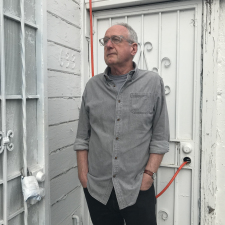
.
Born and educated in England, Charles Ingham moved to California in 1982. He has always been interested in hybrid forms and the intersection of literature and the visual arts, his photography often seeking to transgress the traditional boundaries separating the verbal and the visual.
Ingham lives in San Diego and shows his work at Distinction Gallery in Escondido. He recently had three pieces accepted for the 28th Annual Juried Exhibition at the Athenaeum Music and Arts Library, La Jolla. He also had two pieces shown in the “Six-Word Story” exhibitions at Front Porch Gallery, Carlsbad, and the Oceanside Museum of Art.
His work can be found.at his website: charlesingham.com
.
.
.
.
.
.






